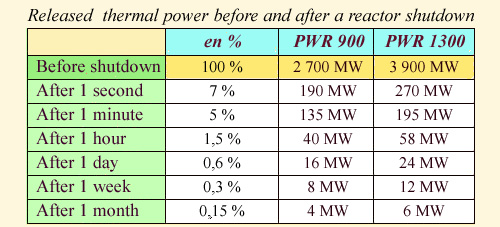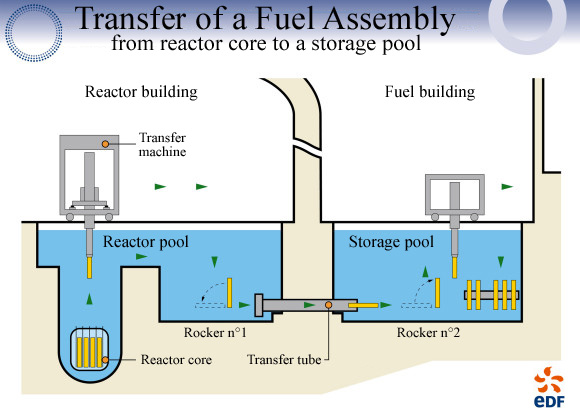The embers of fission …
When shutting down the reactor, whether for reloading the fuel or an accident it is imperative to continue to cool the reactor core for a relatively long time. The chain reaction is indeed interrupted, but the fission products present in the fuel continue to generate heat – a residual power – through their decays.

A strong initial residual heat
Decrease over time of the heat release after a shutdown for pressurized water reactors of 900 and 1300 megawatts (MW). Considerable heat is released immediately after the shutdown. This heat will then decrease by several orders of magnitude, but its evacuation through the steam generators is crucial during the first moments to avoid a reactor core melting, a major accident. When the released heat have sufficiently decreased, a cooling device specific to a shut down reactor takes over.
© EDF/Electra
One second after shutdown, this residual power still represents 7% of the power of the reactor in operation. It fells to the order of 1.5% after one hour, then decreases less and less quickly. These are considerable heat. In the case of a 0.9 GWe (gigawatt) reactor that supplies electricity to around one million people, the heat output is 190 MW thermal after one second, enough to boil half a tonne of water during this second.
The evolution of the heat release during the first moments shows that it is the decays of the very short-lived fission products that are mainly responsible for this intense heat released. In addition during the first hundred seconds, there is also the heat released by late fissions due to delayed neutrons.
Normal shutdowns and unloading spent nuclear fuel
Normally, a shutdown of the reactor is planned every year to discharge a portion of the spent fuel, usually one third. The unloaded assemblies are cooled by the water of the reactor pool during their transfer to the fuel building: here, it is the water of the fuel pool that will continue to cool them until their evacuation in France to the la Hague reprocessing plant. This unloaded fuel is replaced by fresh fuel assemblies that are loaded in the core. This shutdown of the reactor is often used for maintenance operations.

Unloading of spent nuclear fuel
To proceed with the unloading and the replacement of the fuel, the lid of the reactor vessel is removed, the tank remains under water. A transfer machine seizes spent fuel assemblies and, through a transfer tube, discharges them into an adjacent storage pool located in the nearby fuel building. Once the spent fuel assemblies evacuated, one proceeds to their replacement by new assemblies.
© EDF/ManutComb – DG07
Reactor shutdown in case of urgency
In the case of accidental situations resulting in a urgent reactor shutdown, the residual power can be evacuated by the usual means if the cooling circuits are not damaged. If, on the contrary, it is a failure that compromises precisely the good evacuation of the heat of the fuel that has caused the shutdown, the situation can be very delicate. This has led to provide many backup systems able to provide ultimate effective fuel cooling. The study of the cooling accidents and the analysis of the remedies put in place to answer them constitute one of the first concerns in terms of safety.
Cooling failures after an emergency shutdown of a reactor were the first cause of serious accidents, before the loss of fission reactions control. This is evidenced by the accidents at Three Mile Island in 1986 and at Fukushima in 2011. The first led to the loss of one reactor, the second to the loss of 3 reactors and releases of radioactivity into the environment.
Other articles on the subject « Reactor Safety »
Confining Radioactivity
Three barriers … One major challenges of nuclear installations safety is to master the conf[...]
Reactors Cooling
Evacuate the heat of fissions and radioactive decays To ensure the safety of a reactor requires t[...]
Reactor maintenance
Provide the best safety for reactors during decades Nuclear reactors are designed to operate for [...]